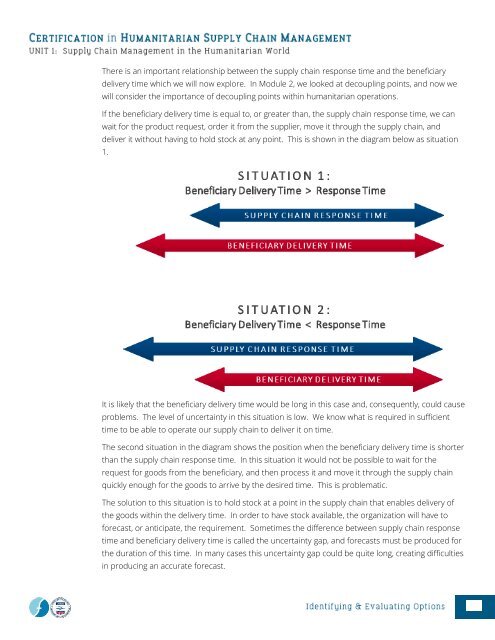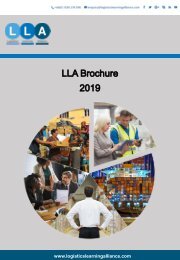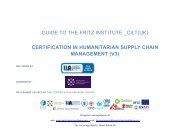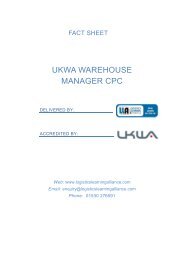CHSCM 3.0 - Unit 1 - SCM in the Humanitarian World
Learning Materials for Unit 1 of the Certification in Humanitarian Supply Chain Management (CHSCM).
Learning Materials for Unit 1 of the Certification in Humanitarian Supply Chain Management (CHSCM).
Create successful ePaper yourself
Turn your PDF publications into a flip-book with our unique Google optimized e-Paper software.
There is an important relationship between <strong>the</strong> supply cha<strong>in</strong> response time and <strong>the</strong> beneficiary<br />
delivery time which we will now explore. In Module 2, we looked at decoupl<strong>in</strong>g po<strong>in</strong>ts, and now we<br />
will consider <strong>the</strong> importance of decoupl<strong>in</strong>g po<strong>in</strong>ts with<strong>in</strong> humanitarian operations.<br />
If <strong>the</strong> beneficiary delivery time is equal to, or greater than, <strong>the</strong> supply cha<strong>in</strong> response time, we can<br />
wait for <strong>the</strong> product request, order it from <strong>the</strong> supplier, move it through <strong>the</strong> supply cha<strong>in</strong>, and<br />
deliver it without hav<strong>in</strong>g to hold stock at any po<strong>in</strong>t. This is shown <strong>in</strong> <strong>the</strong> diagram below as situation<br />
1.<br />
It is likely that <strong>the</strong> beneficiary delivery time would be long <strong>in</strong> this case and, consequently, could cause<br />
problems. The level of uncerta<strong>in</strong>ty <strong>in</strong> this situation is low. We know what is required <strong>in</strong> sufficient<br />
time to be able to operate our supply cha<strong>in</strong> to deliver it on time.<br />
The second situation <strong>in</strong> <strong>the</strong> diagram shows <strong>the</strong> position when <strong>the</strong> beneficiary delivery time is shorter<br />
than <strong>the</strong> supply cha<strong>in</strong> response time. In this situation it would not be possible to wait for <strong>the</strong><br />
request for goods from <strong>the</strong> beneficiary, and <strong>the</strong>n process it and move it through <strong>the</strong> supply cha<strong>in</strong><br />
quickly enough for <strong>the</strong> goods to arrive by <strong>the</strong> desired time. This is problematic.<br />
The solution to this situation is to hold stock at a po<strong>in</strong>t <strong>in</strong> <strong>the</strong> supply cha<strong>in</strong> that enables delivery of<br />
<strong>the</strong> goods with<strong>in</strong> <strong>the</strong> delivery time. In order to have stock available, <strong>the</strong> organization will have to<br />
forecast, or anticipate, <strong>the</strong> requirement. Sometimes <strong>the</strong> difference between supply cha<strong>in</strong> response<br />
time and beneficiary delivery time is called <strong>the</strong> uncerta<strong>in</strong>ty gap, and forecasts must be produced for<br />
<strong>the</strong> duration of this time. In many cases this uncerta<strong>in</strong>ty gap could be quite long, creat<strong>in</strong>g difficulties<br />
<strong>in</strong> produc<strong>in</strong>g an accurate forecast.
















